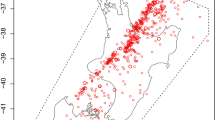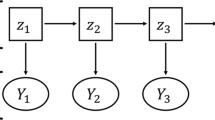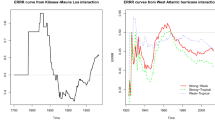Abstract
In this paper, we introduce one type of Markov-Modulated Poisson Process (MMPP) whose arrival times are associated with state-dependent marks. Statistical inference problems including the derivation of the likelihood, parameter estimation through EM algorithm and statistical inference on the state process and the observed point process are addressed. A goodness-of-fit test is proposed for MMPP with state-dependent marks by utilizing the theories of rescaling marked point process. We also perform some numerical simulations to indicate the effects of different marks on the efficiencies and accuracies of MLE. The effects of the attached marks on the estimation tend to be weakened for increasing data sizes. Then we apply these methods to characterize the occurrence patterns of New Zealand deep earthquakes through a second-order MMPP with state-dependent marks. In this model, the occurrence times and magnitudes of the deep earthquakes are associated with two levels of seismicity which evolves in terms of an unobservable two-state Markov chain.
Similar content being viewed by others
References
Asmussen S., Nerman O., Olsson M. (1996) Fitting phase-type distribution via the EM algorithm. Scandinavian Journal of Statistics 23: 419–441
Baddeley A.J., Turner R., Møller J., Hazelton M. (2005) Residual analysis for spatial point processes (with discussion). Journal of the Royal Statistical Society, Series B, 67: 617–666
Cressie N.A.C. (1991) Statistics for spatial data. Wiley, New York
Daley D.J., Vere-Jones D. (2008) An introduction to the theory of point processes (Vol. II). Springer, Berlin
Dempster A.P., Laird N.M., Rubin D.B. (1977) Maximum likelihood from incomplete data via the EM algorithm. Journals of the Royal Statistical Society, Series B 39: 1–38
Deng L., Mark J.W. (1993) Parameter estimation for Markov modulated Poisson processes via the EM algorithm with time discretization. Telecommunication Systems 1: 321–338
Elliott R.J., Malcolm W.P. (2005) General smoothing formulas for Markov-modulated Poisson observations. IEEE Transactions on Automatic Control 50: 1123–1134
Fischer W., Meier-Hellstern K. (1993) The Markov-modulated Poisson process (MMPP) cookbook. Performance Evaluation 18: 149–171
Frohlich C. (2006) Deep earthquakes. Cambridge University Press, UK
Ito H., Amari S.I., Kobayashi K. (1992) Identifiability of hidden Markov information sources and their minimum degrees of freedom. IEEE Transactions on Information Theory 38(2): 324–333
Jensen, A. T. (2005). Statistical inference for doubly stochastic Poisson processes. PhD Thesis, University of Copenhagen.
Klemm A., Lindemann C., Lohmann M. (2003) Traffic modeling of IP networks using the batch Markovian arrival process. Performance Evaluation 54(2): 149–173
Lu, S. (2009). Extensions of Markov modulated Poisson processes and their applications to deep earthquakes. PhD Thesis, Victoria University of Wellington.
MacDonald I.L., Zucchini W. (1997) Hidden Markov and other models for discrete-valued time series. Chapman & Hall, London
McLachlan G.J., Krishnan T. (1997) EM algorithm and extensions. Wiley, New York
Meier-Hellstern K.S. (1987) A fitting algorithm for Markov-modulated Poisson processes having two arrival rates. European Journal of Operational Research 29: 370–377
Ogata Y. (1988) Statistical models for earthquake occurrences and residual analysis for point processes. Journal of the American Statistical Association 83(401): 9–27
Reyners M. (1989) New Zealand seismicity 1964–87: An interpretation. New Zealand Journal of Geology and Geophysics 32: 307–315
Roberts W.J.J., Ephraim Y., Dieguez E. (2006) On Ryden’s EM algorithm for estimating MMPPs. IEEE in Signal Processing Letters 13(6): 373–376
Ryden T. (1996a) An EM algorithm for estimation in Markov-modulated Poisson processes. Computational Statistics and Data Analysis 21: 431–447
Ryden T. (1996b) On identifiability and order of continuous-time aggregated Markov chains, Markov-modulated Poisson processes, and phase-type distributions. Journal of Applied Probability 33: 640–653
Van Loan C.F. (1978) Computing integrals involving the matrix exponential. IEEE Transactions on Automatic Control, AC- 23(3): 395–404
Vere-Jones D., Schoenberg F. (2004) Rescaling marked point processes. Australian & New Zealand Journal of Statistics 46(1): 133–143
Vere-Jones D., Turnovsky S., Eiby G.A. (1964) A statistical survey of earthquakes in the main seismic region of New Zealand. New Zealand Journal of Geology and Geophysics 7(4): 722–744
Author information
Authors and Affiliations
Corresponding author
About this article
Cite this article
Lu, S. Markov modulated Poisson process associated with state-dependent marks and its applications to the deep earthquakes. Ann Inst Stat Math 64, 87–106 (2012). https://doi.org/10.1007/s10463-010-0302-9
Received:
Revised:
Published:
Issue Date:
DOI: https://doi.org/10.1007/s10463-010-0302-9




